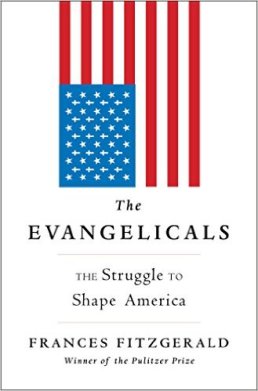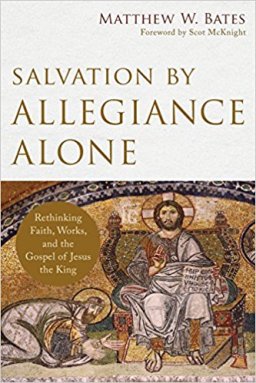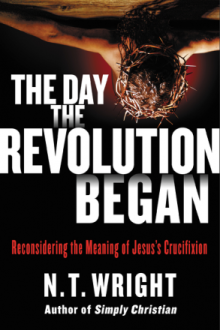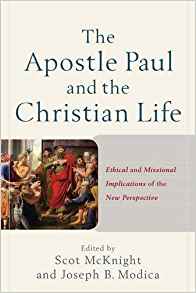
The Apostle Paul and the Christian Life: Ethical and Missional Implications of the New Perspective Eds. Scot McKnight and Joseph B. Modica
Baker Academic, 2016. 209 pp.
What is it that makes a person a Christian? Or, more specifically, what does it mean to apply Paul’s letters to the center of the Christian life, especially in the light of the “new perspective” of Pauline exegesis? Those provocative questions orient The Apostle Paul and the Christian Life, an important volume that belies its small stature. There’s a lot packed into barely two hundred pages here and because of its subject matter —Paul tells us that everything is different now because of the good news of Jesus—it is not a quick read. Let me briefly recount what I think are the two strongest features of the book before diving into some comments on what the new perspective is and then concluding with more detailed exposition of why the contributors to this volume think the new perspective on Paul (NPP) matters so much for how we read Paul and apply his letters to the Christian life. Given the scope this book covers (nothing less than the whole of the Christian life) and the lens through which it does so (nothing less than the first revolution in Pauline exegesis since the 1500s) this review has turned into a bit of an essay itself!
- Introduction
The most important and notable element of this book is the centrality of the person of the Spirit to the each contributor’s understanding of the Christian life—a welcome surprise given the absence of the Spirit in many presentations of the Christian life. Jimmy Dunn’s treatment of Galatians in the first essay of the volume sets the stage for the prominence of the third Person of the Trinity throughout:
If Paul’s emphasis on faith—we might properly say faith alone—is so clear in Galatians, it is equally noticeable that the gift of the Spirit is almost as important for Paul in the same letter. Indeed, it is somewhat surprising that in the history of interpretation…much greater emphasis has been given to the importance of ‘justification by faith’ in Galatians that to the gift of the Spirit… (10).
Patrick Mitchel says the same thing, but more provocatively: “The Galatians’ reception of the Spirit by faith, just as much as their justification by faith, is a fulfillment of the blessing promised by God to Abraham” (92).
If you had asked me prior to reading Dunn’s and Mitchel’s essays in what Pauline letters the Spirit plays a prominent role, Galatians would not have come to mind. This book provided a welcome corrective to my poor readings of Galatians. In fact, this volume brings out the striking reality that without an intentionally focused hermeneutic of reading Paul through the lens of the centrality of the Spirit in the Christian life (hunt the pigeon! Sarah Coakley says in God, Sexuality and the Self), one will not read Paul well at all. Case in point: my reading of Galatians solely in terms of “justification”. These essays understand that the Spirit is the Person who empowers the believer to actually live as Jesus commanded. (I was struck reading the gospel according to John today that Jesus tells his disciples that it is actually better for Him to leave so that the Spirit might come upon them [16:17]. Do we take the Spirit seriously enough to take Jesus at his word?)
The second most important feature of this volume is the way in which the essays are soaked in Scripture. The contributors have not availed themselves of the opportunity to give a window dressing treatment of Paul in order to tell us what they really believe the Christian life is all about. They have taken Pauline exegesis and its importance quite seriously and it’s clear that each writer has a high value for Scripture. In fact, the index of Scripture citations takes up six pages at the back of an already short volume. The amount of Scripture included in each essay makes this book a slow read, like I mentioned above, but it also provides the reader with a tour through the letters of Paul
Let’s turn now to the way the readers interpret Paul. What is the “new perspective on Paul” and why does it matter?
2. The New Perspective on Paul
The subtitle of The Apostle Paul and the Christian Life is, “Ethical and Missional Implications of the New Perspective.” I imagine to some picking up this book that will prove something of an enigma. The new perspective on what, exactly? The editors, Scot McKnight and Joseph Modica, assume that the new perspective on Paul is ubiquitous enough of a term now to omit the genitive of ownership—the new perspective on Paul—and while that may, indeed, be the case, it would seem worthwhile to provide a brief foray into the new perspective in order to be able to provide any comment in the last section on why the contributors in the book think its vital to read Paul in this way. There are those that will scoff at the last sentence: “Of course we know what Paul was trying to get at and even the suggestion of a “new perspective” means that you have all lost the ‘gospel,’” I can well imagine someone saying. But this volume proves that those who think the new perspective is an important corrective to distortions in the reading of Paul are just as devoted to the text and the message of Scripture as those who warn their flock of this “dangerous reading” of Paul as I myself have been advised.
The three-page introduction (I told you it is a short volume!) gets the ball rolling by referring to the “origins and impact of the NPP”, beginning with the trifecta of Krister Stendahl, Ed Sanders, and Jimmy Dunn (xi). Perhaps those names are familiar to you, perhaps not. If not, that’s ok, but hang on because what they have to say is important, if for no other reason than it’s a virtue to be confident enough in the truth of Jesus to listen to what those who take Scripture seriously have to say, even if you’ve only heard nasty things about it.
If you’d allow me a fairly extensive autobiographical note at this point,—which hopefully will help flesh out why the new perspective should matter to you— my first true wrestling with the NPP (outside of a general reading of N.T. Wright) came not five years ago at a table in a small shack on vacation in the lake of the Ozarks. For several years before that vacation, I had been doing a fair amount of reading on the conflagration over the doctrine of justification between John Piper and N.T. Wright (including attending the seminal 2010 Evangelical Theological Society meeting between Wright and Schreiner) and was lead to a small little book by Krister Stendahl. Stendahl, I read, was a Lutheran pastor and scholar that needed to be taken seriously in order to understand the modern context of Pauline studies of which the debate over justification was but one part of the whole. (As any true student of any subject will know, trying to immerse oneself in one topic almost inevitably leads to the necessity of reading a whole trove of other books which provide the larger context which enables you to even begin to get into the material one originally intended to study.) Stendahl’s book, Paul Among Jews and Gentiles (1976), was small enough that I felt like I could take it on vacation and have the chance time to finish it without it being too mentally draining for me to have a restful vacation.
If the idea for my vacation was for some mental relaxation, the book proved to be a poor choice. The book proved to be a fairly quick read, indeed, but its contents were both frustrating and exciting to my then current understanding of Paul. Paul, I had been taught, was the guy that made it relatively clear that the purpose and fulfillment of Jesus’ mission on earth was to die so that we might be saved from our sins, thereby attaining salvation and reserving our spot in heaven after death. Our “acceptance” of this message meant that we trusted in its historical truth correctness through our faith and that its life-changing ramifications would mean that we became people through which the fruits of the spirit were developing. A good Christian would tell his or her friends this good news: you can stop trying to be good people in order to make yourself ready for heaven, that’s impossible. Instead, you can that you are a forgiven sinner because you are forgiven through Jesus and can now be sure that you will go to heaven when you die! Any good friend in my circle would have immediately known what the question, “where are you going?” was truly about. We weren’t asking people if they were going to the mall!
I considered this summation of Paul’s message of Jesus life as pretty much the gospel truth aside from the obvious untruth that salvation involved going to heaven. We were meant for the new heavens and new earth that really began here and now I never tired of telling people! But essentially, that’s what Paul wrote and so that’s what we should be telling folks. But reading Stendahl that day at the lake made me question whether or not that reading of Paul could still hold.
Now I know that some at this point may want to say to themselves, well that’s because Stendahl must be preaching a false gospel that must be rejected. But hold on, because that’s not what Stendahl was doing.
What he was doing, was asking whether or not we have been reading Paul well. The question that he asked in its essence was: “Have we been reading Paul as Paul’s 1st century Jewish audience would have read him, or have we been reading him with our 16th century Reformation spectacles on?” Stendahl made me ask things like: Do the “works of the law” that Paul often refers mean simply “good deeds” as Luther would have it, or is Paul talking about something specifically Jewish? Is the message of salvation primarily addressed to individuals or is there a larger, corporate element that we have missed?
Stendahl’s little book went quite a ways to convincing a lot of people, myself included, that we have not been reading Paul from the understanding of his original audience but from the questions that the Reformers were asking. Stendahl showed me that the old perspective reading, while not “wrong” necessarily, certainly didn’t contain the fullness of what Paul was getting at.
That same day after reading Stendahl, I went back to read Galatians, one of the two most important sites of the NPP (the other being Romans) and thinking, “Stendahl has raised some really important questions but now I can’t make heads or tails of this text. If Stendahl is right, Galatians seems to be a completely irrelevant old book on a debate between the finer points of the Jewish “works of law.” I was both excited and confused. My “old perspective” reading of Paul no longer seemed possible but what I was learning was the “new perspective” seemed irrelevant at best. Where did I go from here?
Enter the second character in the trifecta that the introduction lists, E.P. Sanders. Sanders volume, Paul and Palestinian Judaism challenged the prevalent understanding that the Jews of Paul’s day thought that they could earn their salvation through “works of the law.” Without getting in to any detail, Sanders’ book caused a massive shift in understanding the attitude with which Jews approached their standing under the covenant and, thus, their “salvation”. The introduction to The Apostle Paul and the Christian life says that what Sanders’ book did was shift the understanding that “Judaism was not a works-based religion emerging from human effort but one emerging from divine election and the obedience expected of those who were already in the covenant” (xii). Sanders termed this understanding of Judaism, covenantal nomism. That is, the covenant is what “gets one in” and following the works of the law is what allows one to “stay in.”
The last character in the trio is Jimmy Dunn who caused everyone to rethink just exactly what the contentious phrase “works of the law” (ta erga nomou) was referring to. Dunn saw the phrase as referring to “badges” or “boundary markers” of the Jews like food laws, circumcision etc., which Paul criticized on account of the new saving work of Jesus. It was Dunn that applied Sanders’ shifts in understanding to Paul.
To put it simply, the new perspective changed the question from Luther’s (and the “Old Perspective’s”) “how can I as a sinner find a gracious God” to the question that embodies the heart of Paul much more holistically: “what effect has the incarnation of Jesus had on who are now truly part of the covenant people of God?”
That’s as far as I think we should go into the history of the NPP in this review; if you are unfamiliar with it, I hope that this has whetted your appetite to learn more and, ultimately, to go back to Paul’s letters. For my money, Patrick Mitchel’s essay is the most substantial contribution in The Apostle Paul and the Christian Life and he provides a good introduction to the NPP in a short amount of space. McKnight and Modica suggest Keith Yinger’s The New Perspective on Paul: An Introduction, which I would also recommend (it’s only about 100 pages), and also Michael B. Thompson’s The New Perspective on Paul as useful introductions, though I can only speak to Yinger’s fair treatment.
III. Going Deeper
In the introduction, McKnight and Modica state that their reason for using the new perspective as the lens through which the book reads the apostle Paul is because it “offers a fresh and rich approach as one grapples with the Apostle Paul’s understanding of the Christian life” (xiii). One of the results of the NPP Timothy Gombis says in his essay is, “the space created for reading justification in the contexts of Paul’s arguments and for allowing many other aspects of Paul’s richly textured theology to emerge into view” (103). That’s a fine summary of what the contributors of this volume believe the NPP has to offer for the life of everyday discipleship: a renewed look at the letters of Paul that focus on the Spirit and the Church rather than heaven and the individual. No other writer is as critical of the Old Perspective’s emphasis on individual justification and holiness as Scot McKnight this lengthy quotation suggests:
The old perspective generated an individualistic understanding of the Christian life; the old perspective focused on personal redemption and thus on happiness now and eternal life with God when we die; the old perspective saw the mission of God in getting people saved, even if the word salvation gets expanded into the social sector for some; the old perspective tended at times (not always) to minimize social efforts because personal redemption and eternal life became the whole message; the old perspective never had ecclesiology at its center and sometimes diminished the church” (128, original emphasis).
For McKnight, it is clear that the importance of the new perspective lies in the move away from the individual and toward the community united in love for one another through the Spirit of Christ:
The mission of the apostle Paul is to form fellowships in separate cities that embody the new sociopolitical and economic and spiritual order….My contention is that for Paul the Christian life was learning how to live in this new ecclesial identity that demonstrated to Rome not is parading of power and status but instead a parade of sacrificial love and care for all. This is why I contend we need to reclaim Paul for the American church (145).
To sum up: The Apostle Paul and the Christian Life is a welcome addition not only to Pauline studies but also to the everyday life of the Christian disciple. It is a unique volume, employing a formidable cast of New Testament scholars who take the footnotes of Pauline scholarship very seriously but do so in this volume in order to help the believer interact with her colleagues at work in a more thoroughly Pauline, that is to say, Christo-centric, way. This book takes the new perspective seriously as a reading of Paul that has major ramifications for everyday discipleship and for furthering the life and mission of the Church. At barely two-hundred pages, it is a serious work not only for those curious about the new perspective but for the seasoned scholar as well because it furthers our understanding of just what Paul’s letters are all about. For those who take Paul and Scripture seriously enough to come back to the text daily and wrestle anew with what the Spirit is doing in the pages and words of the living word of God, The Apostle Paul and the Christian Life is a vital read.
 n how the death and resurrection of Jesus’ death have changed everything. It felt unwise to attempt a comprehensive book review for two reasons: one, because of the massive amount of ground he covers in the book and two, Leithart’s book has already received pretty comprehensive treatment in the blogosphere of it already. So I what I want to do is use it as a springboard for some reflections during Holy Week. Let me first offer some book-review type opening thoughts on the style and purpose of the book before getting into some more informal and personal reflections throughout the rest of Holy Week.
n how the death and resurrection of Jesus’ death have changed everything. It felt unwise to attempt a comprehensive book review for two reasons: one, because of the massive amount of ground he covers in the book and two, Leithart’s book has already received pretty comprehensive treatment in the blogosphere of it already. So I what I want to do is use it as a springboard for some reflections during Holy Week. Let me first offer some book-review type opening thoughts on the style and purpose of the book before getting into some more informal and personal reflections throughout the rest of Holy Week.

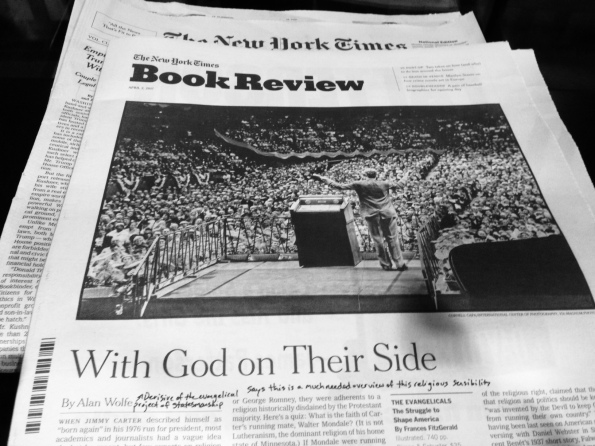 There’s a big new book on evangelicalism coming out on Tuesday that I wish I had time to stop life for and read right away, but which I hope to get to soon. It’s titled The Evangelicals: The Struggle to Shape America and it’s written by Francis FitzGerald, published by Simon & Schuster. The thing is a monster, clocking in at 740 pp.
There’s a big new book on evangelicalism coming out on Tuesday that I wish I had time to stop life for and read right away, but which I hope to get to soon. It’s titled The Evangelicals: The Struggle to Shape America and it’s written by Francis FitzGerald, published by Simon & Schuster. The thing is a monster, clocking in at 740 pp.